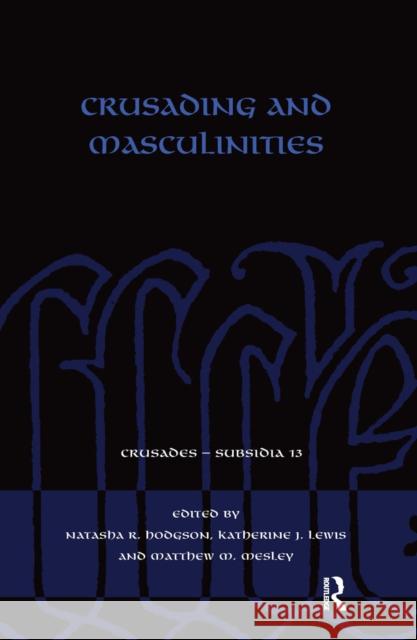Crusading and Masculinities » książka



Crusading and Masculinities
ISBN-13: 9780367660611 / Angielski / Miękka / 2020 / 378 str.
Crusading and Masculinities
ISBN-13: 9780367660611 / Angielski / Miękka / 2020 / 378 str.
(netto: 196,79 VAT: 5%)
Najniższa cena z 30 dni: 201,44 zł
ok. 16-18 dni roboczych.
Darmowa dostawa!
This volume presents the first substantial exploration of crusading and masculinity.
List of Contents
Acknowledgements
Contributor’s Biographies
Introduction
By Natasha R. Hodgson, Katherine J. Lewis and Matthew M. Mesley.
Sources and Models
1. Christoph T. Maier, ‘Propaganda and masculinity: gendering the crusades in thirteenth-century sermons’.
2. Simon Thomas Parsons, ‘The valiant man and the villain in the tradition of the Gesta Francorum: overeating, taunts and Bohemond’s heroic status.’
3. Mathew Barber, ‘Al-Afḍal B. Badr Al-Jamālī, The Vizierate and the Fatiid Response to the First Crusade: Masculinity in Historical Memory.’
4. Anne-Lydie Dubois, ‘The adolescent and the crusader: journey and rebirth on the path to manhood in the thirteenth century.’
Contrasting Masculinities
5. Yvonne Friedman, ‘Masculine Attributes of the Other: The Shared Knightly Model.’
6. Helen J. Nicholson, ‘The true gentleman? Correct behavior towards women according to Christian and Muslim writers during the period of the crusades.’
7. Alan V. Murray, ‘Contrasting masculinities in the crusades against Lithuania: Teutonic knights and crusades in war and recreation in late medieval Prussia.’
8. James Doherty, ‘"You stayed at home as though you were the daughter of your father": gendered insults and crusading masculinities in medieval sagas’.
Emasculation and Transgression
9. Joanna Phillips, ‘Crusader masculinities in health crises, 1095-1274.’
10. Susan B. Edgington, ‘Emasculating the enemy: Wicher the Swabian’s fight with the Saracen giant’.
11. Niall Christie, ‘Fighting women in the crusading period through Muslim eyes: transgressing expectations and facing realities’.
Masculinity and Religiosity
12. Natasha R. Hodgson, ‘Leading the people "as duke, count and father": the masculinities of Abbot Martin of Paris in Gunther of Paris’ Hystoria Constantinopolitana.’
13. Beth Spacey, ‘ "Unus contra omnes": representing martyrdom and masculinities in the Itinerarium Peregrinorum et Gesta Regis Ricardi’.
14. Linda Jones, ‘Mediterranean Masculinities? Reflections of Muslim and Christian Manliness in Medieval Iberian Crusade and Jihad Narratives’.
15. Erika Tritle, ‘A Jewish solution to the problem of excessive Christian virility in the war against Spanish Islam’.
Chivalry and Kingship
16. Matthew M. Mesley, ‘Performing Plantagenet Kingship: Crusading and Masculinity in Matthew Paris’s Chronica Majora’.
17. David Cantor-Echols, ‘Kingship on crusade in the Chronicle and Poem of Alfonso XI of Castile’.
18. Katherine J. Lewis, ‘...doo as this noble prynce Godeffroy of boloyne dyde: Chivalry, Masculinity and Crusading in late Medieval England.’
19. Robert B. Desjardins, ‘Lest his men mutter against him’: Chivalry and artifice in a Burgundian crusade chronicle’.
Afterword
Ruth Mazo Karras
Index
Natasha R. Hodgson is Senior Lecturer in Medieval History and Director of the CSRC at Nottingham Trent. She wrote Women, Crusading and the Holy Land and is completing Gender and the Crusades for Palgrave Macmillan. She edits Routledge series’ Advances in Crusades Research and Themes in Medieval and Early Modern History and co-edits the journal, Nottingham Medieval Studies.
Katherine J. Lewis is Senior Lecturer in History at the University of Huddersfield. She researches later medieval religious and cultural history. She has published on hagiography and saints’ cults (especially St Katherine of Alexandria), on medieval women, and on masculinity, including Kingship and Masculinity in Late Medieval England.
Matthew M. Mesley is an Associate Lecturer at Bath Spa University and Visiting Research Fellow at the University of Huddersfield. He was formerly a SNSF postdoc at the University of Zürich. His chapter "Chivalry, Masculinity and Sexuality", is published in the forthcoming Cambridge Companion to the Literature of the Crusades.
1997-2025 DolnySlask.com Agencja Internetowa
KrainaKsiazek.PL - Księgarnia Internetowa









